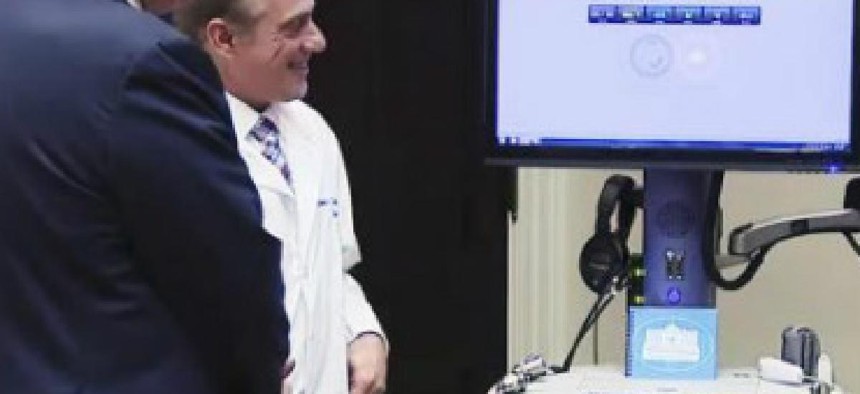VA expands telehealth access

At a White House event, VA Secretary David Shulkin announced the coming nationwide release of an app designed to connect veterans and doctors.

VA Secretary David Shulkin demonstrates the VA's new telehealth app for President Trump at an Aug. 3 White House event.
The Department of Veterans Affairs is rolling out a new application that allows patients to conduct telehealth visits from their home computers and mobile devices.
The VA Connect app, announced Aug. 3 at a White House event, is designed to support the expansion of VA's already-extensive telehealth services. The VA Video Connect app is currently in use in 250 VA facilities, and is expected to complete its nationwide rollout by October.
Additionally, the department moved to reduce some of the regulatory restrictions on telehealth visits to increase veterans' access. The VA currently reaches about 700,000 veterans with hospital-faced telehealth visits. The plan is to expand VA services into patient's homes and the offices of private medical practices. doctors around the country.
"We're expanding the ability of veterans to connect with their VA healthcare team from anywhere using mobile application on the veteran's own phone or the veteran's own computer," President Donald Trump said. "This will significantly expand access to care for our veterans, especially for those who need help in the area of mental health, which is a bigger and bigger request -- and also in suicide prevention.""Technology has given us this advantage, but unfortunately we have not taken advantage of that until now," said Trump.
Secretary of Veterans Affairs David Shulkin called the move "a big deal" for veteran's health care.
"That means we're going to be able to use VA providers in cities where there are a lot of doctors, and be able to use those doctors to help our veterans in rural areas where there aren't many healthcare professionals," he said.
Louis Celli, American Legion's director for veterans affairs and rehabilitation, also applauded the expansion, which he called "a natural progression for the program."
"When tele-health was first introduced, it was always envisioned as the ultimate solution for allowing vets to be as comfortable as possible," he said Celli. "Keep in mind that VA deals with a very large cohort of geriatric patients, so the less disturbance in their day, the better it is for them."
Celli did raise the concern of veterans' connectivity, however. "One of the things that we’re a little leery of is veterans who may want to participate, but don’t have great internet access in the remote regions where they live," he said. "That would really be the only thing that we would be concerned about.... But for veterans who are housebound or physically challenged, tele-health can be an excellent way for a physician to check in."
Telemedicine has grown increasingly popular over the past decade, but regulations, largely state-based, have lagged. In April, the House introduced legislation to allow VA doctors to provide telehealth technology to patients across state lines without running afoul of licensing laws. In May, a bipartisan group of senators introduced legislation to expand the practice for Medicare recipients.
Shulkin, a physician who formerly led the Veterans Health Administration and who still sees patients, donned a white lab coat and gave the president and reporters a live demonstration of a typical telehealth appointment, connecting by video feed to a patient in Grants Pass, Ore. The patient had a skin condition and doctors in Grants Pass were able to immediately transmit photos and other medical documents to Shulkin in D.C.
"You look very healthy to me," the president told the patient, drawing laughter from attendees. "Please make sure your skin is perfect."





